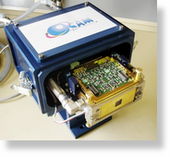
© ESOThe OCam camera
Scientists at the European Southern Observatory (ESO), working together with researchers from three French laboratories, have developed a new ultra-fast camera that can take 1 500 finely exposed images per second. Called OCam, this camera uses the CCD220 detector developed by e2v Technologies in the UK. The team said OCam will be a major component of the next generation of adaptive optics instruments of the ESO's Very Large Telescope (VLT), in particular for the Spectro-Polarimetric High-contrast Exoplanet Research (SPHERE) instrument.
OCam and the CCD220 are the result of five years' work within the OPTICON ('Optical-infrared coordination network for astronomy') project, financed with EUR 19.2 million under the EU's Sixth Framework Programme (FP6). OPTICON, which ran from 2004 to 2008, comprised 23 research institutions from 12 EU Member States, plus one Associated Country (Switzerland).
The team, which consists of researchers from the Astrophysics Laboratory of Marseille, the Astrophysics Laboratory of Grenoble, and the Haute-Provence Observatory in France, said modern adaptive optics instruments used on the largest ground-based telescopes would benefit immensely from OCam. Atmosphere turbulence wreaks havoc on telescopes found on the ground by generating a blurring effect, which distorts the finer details of the images.
'The performance of this breakthrough camera is without an equivalent anywhere in the world. The camera will enable great leaps forward in many areas of the study of the Universe,' explained Dr Norbert Hubin, head of ESO's Adaptive Optics Department.
Adaptive optics techniques succeed in overcoming this problem: telescopes on the ground are able to produce sharp images, as if taken from space. The researchers said adaptive optics is based on real-time corrections computed from images obtained by a special camera working at very high speeds. What is unique about OCam is that its images are taken at an even higher rate.
'The quality of the adaptive optics correction strongly depends on the speed of the camera and on its sensitivity,' said project coordinator Philippe Feautrier from the Astrophysics Laboratory of Grenoble. 'This is why cameras normally used for very high frame-rate movies require extremely powerful illumination, which is of course not an option for astronomical cameras.'
OCam and the CCD220 detector are not only quick, but they are also very sensitive, according to the team. 'Thanks to this technology, all the new-generation instruments of ESO's Very Large Telescope will be able to produce the best possible images, with an unequalled sharpness,' noted Jean-Luc Gach of the Astrophysics Laboratory of Marseille.
Dr Hubin concluded: 'Plans are now underway to develop the adaptive optics detectors required for ESO's planned 42-metre European Extremely Large Telescope, together with our research partners and the industry.'

Reader Comments
to our Newsletter